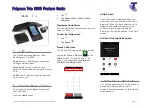
C
omrex
C
orporation
100
Q: How can I optimize settings for EVDO, UMTS, or other wireless
access?
A: Since there is typically already a substantial delay in these networks, it’s
often not a priority to keep ACCESS delay to the absolute minimum. Using
the profile that you set up for the EVDO connection, enter the
Advanced
Options
. Raise the
Frames/Packet
setting to 4 in both
Local
and
Remote
Encoders
. This will reduce overall bandwidth and enhance reliability on
many networks. You may also need to increase
Delay Cushion
on the non-
wireless decode side as described in the previous answer.
Q: I’m paying for my network bandwidth by the megabyte. How can I
conserve?
A: Set both
Local
and
Remote
encoders (in the profile) to
BRIC-ULB
,
which uses by far the lowest amount of data. While setting the profile,
click the
Advanced Options
and set both
Local
and
Return
Frames per
Packet
setting to
4
. This will decrease overhead and preserve bandwidth.
Finally, if you don’t require audio in both directions, disable the return
channel by turning off the
Remote Transmitter
in the profile. As a guide,
an ACCESS set this way will average about 8 minutes of talk time per mega-
byte in each direction.
Q: How can I change modem parameters like dial-tone-detect and
ring cadence detection?
A: Contact Comrex for more info on this.
Q: I notice in the Advanced Options that I can change my streaming
from UDP to TCP. Should I?
A: Not if you want the best overall performance. ACCESS is optimized in
terms of data rate, stability and delay to use UDP. TCP mode increases
overhead and delay, and is included only for environments where UDP
is hopelessly blocked by a firewall. ACCESS decoders do listen to both
TCP and UDP ports and choose whichever arrives first. If an ACCESS gets
an incoming TCP connection, it will establish TCP in the other direction
automatically. One other note for use with TCP — most of the information
presented on the
Statistics Tab
is generated by the UDP functionality, so
you won’t see much here using TCP.
















































